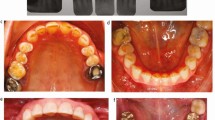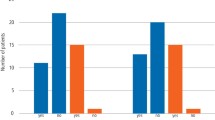Abstract
Aim It is the aim of this paper to present a history of the measurement of restoration survival in teeth in the earliest recorded work.
Methods The literature on restoration survival from 1969 until the development of large datasets was reviewed, using examples drawn from the intervening decades.
Conclusions A number of early clinicians realised the importance of measuring longevity of dental restorations and managed to produce information which was likely to be of value at the time of its publication. However, the work involved in the collection and analysis of such information in the pre-computer era should not be underestimated: it was a true labour of love.
Key points
-
The ability to measure the survival of restorations may be considered central to successful clinical practice.
-
Prior to the computer era, collection of restoration survival data was a labour-intensive and time-consuming process which did not facilitate detailed analysis.
-
A wide variety of descriptions for what defined failure of a restoration was proposed in the past.
This is a preview of subscription content, access via your institution
Access options
Subscribe to this journal
Receive 24 print issues and online access
$259.00 per year
only $10.79 per issue
Buy this article
- Purchase on SpringerLink
- Instant access to full article PDF
Prices may be subject to local taxes which are calculated during checkout


Similar content being viewed by others
Data availability
Any data included in the study are available in the cited papers, including SN7024, available from UKDataService.ac.uk.
References
Lucarotti P S K, Holder R L, Burke F J T. Analysis of an administrative database of half a million restorations over 11 years. J Dent 2005; 33: 791-803.
Allan D N. The durability of conservative restorations. Br Dent J 1969; 126: 172-177.
Harris R. Standardization of inlay technique. Dent J Aust 1940; 12: 513-526.
Black G V. The management of enamel margins. Dent Cosmos 1891; 33: 1-14.
Robinson A D. The life of a filling. Br Dent J 1971; 130: 206-208.
Combe E, Burke F J T, Douglas W H. Dental Biomaterials. Boston: Kluwer Academic, 1999.
Allan D N. A longitudinal study of dental restorations. Br Dent J 1977; 143: 87-89.
Allan D N. Dental restoration review praised. Br Dent J 1999; 187: 632.
Paterson N. The longevity of restorations. Br Dent J 1984; 157: 23-25.
Hawthorne W S, Smales R J. Factors influencing long term restoration survival in three private dental practices in Adelaide. Aust Dent J 1997; 42: 59-63.
Downer M C, Azli N A, Bedi R, Moles D R, Setchell D J. How long do routine dental restorations last? A systematic review. Br Dent J 1999; 187: 432-439.
Lucarotti P S K. The life expectancy of dental restorations placed within the General Dental Services in England and Wales. Birmingham: University of Birmingham, 2003. PhD Thesis.
Jokstad A, Bayne S, Blunck U, Tyas M, Wilson NF. Quality of dental restorations. Int Dent J 2001; 51: 117-158.
Manhart J, Hickel R A. Longevity of restorations. In Wilson N H F, Roulet J-F, Fuzzi M (eds) Advances in Operative Dentistry Vol 2. pp 237-304. Chicago: Quintessence Publishing, 2001.
Randall R C, Wilson N H. Clinical testing of restorative materials: some historical landmarks. J Dent 1999; 27: 543-550.
Manhart J, Garcia-Godoy F, Hickel R. Direct posterior restorations: clinical results and new developments. Dent Clin North Am 2002; 46: 303-339.
Hickel R, Folwaczny M. Various forms of glass ionomers and compomers. Oper Dent 2001; 6: 177-190.
Van Dijken J W V. A 6-year clinical evaluation of Class I poly-acid modified resin composite/resin composite laminate restorations cured with a two-step curing technique. Dent Mater 2003; 19: 423-428.
Blatz M B. Long term clinical success of all-ceramic posterior restorations. Quintessence Int 2002; 33: 415-426.
Phillips C, Rees J S, Jones R J. Issues in assessing the cost effectiveness of dental restorations. Dent Syst Rev 2000.
Jedynakiewicz N M, Martin N. Posterior restorations - a clinical view. J Adhes Dent 2001; 3: 101-110.
Elderton R J. The causes of failure of restoration: a literature review. J Dent 1976; 4: 257-262.
Elderton R J. The prevalence of failure of restorations: a literature review. J Dent 1976; 4: 207-210.
Elderton R J, Nuttall N M. Variation among dentists in planning treatment. Br Dent J 1983; 154: 201-206.
Nuttall N M, Elderton R J. The nature of restorative dental treatment decisions. Br Dent J 1983; 154: 363-365.
Robbins J W, Summit J B. Longevity of complex amalgam restorations. Oper Dent 1988; 13: 54-57.
Mjör I A. Amalgam and composite resin restorations: longevity and reasons for replacement. In Anusavice K J (ed) Quality Evaluation of Dental Restorations. pp 61-72. Chicago: Quintessence, 1989.
Mjör I A, Jokstad A, Qvist V. Longevity of posterior restorations. Int Dent J 1990; 40: 11-17.
Jokstad A, Mjör I A. Analyses of long-term clinical behavior of class-II amalgam restorations. Acta Odontol Scand 1991; 49: 47-63.
Bader J D, Shugars D A. Understanding dentists' restorative treatment decisions. J Public Health Dent 1992; 52: 102-110.
Bader J D, Shugars D A. Variation in dentists' clinical decisions. J Public Health Dent 1995; 55: 181-188.
Bader J D, Shugars D A. Variation, treatment outcomes, and practice guidelines in dental practice. J Dent Educ 1995; 59: 61-95.
Chadwick B, Treasure E, Dummer P et al. Challenges with studies investigating longevity of dental restorations - a critique of a systematic review. J Dent 2001; 29: 155-161.
Treasure E, Chadwick B L, Jones R J. Restoration longevity - recommendations on reporting requirements for publication. Dent Syst Rev 2000.
Dunstan F D J, Jones R J, Treasure E. A systematic review of dental restoration longevity - statistical issues. Dent Syst Rev 2000.
El-Mowafy O M, Lewis D W, Benmergui C, Levinton C. Meta-analysis on long-term clinical performance of posterior composite restorations. J Dent 1994; 22: 33-43.
Sheldon T, Treasure E. Dental restoration: what type of filling? Eff Health Care 1999; 5: 1-11.
Burke F J T. Measuring restoration longevity: it's easier now! Dent Update 2022; 49: 783-786.
Acknowledgements
The authors acknowledge the support of the Economic and Social Data Service, the Health and Social Care Information Centre and the NHS Business Services Authority for collating and releasing this valuable data resource. Part 2 of this paper will be published in an upcoming issue of the BDJ.
Author information
Authors and Affiliations
Contributions
FJTB and PSKL conceived and designed the work that led to the submission, interpreted the results from the contributing papers, drafted the manuscript and approved the final version.
Corresponding author
Ethics declarations
The authors declare no conflicts of interest.
Rights and permissions
Springer Nature or its licensor (e.g. a society or other partner) holds exclusive rights to this article under a publishing agreement with the author(s) or other rightsholder(s); author self-archiving of the accepted manuscript version of this article is solely governed by the terms of such publishing agreement and applicable law.
About this article
Cite this article
Burke, F., Lucarotti, P. Measurement of restoration longevity: from Robinson's rules to a 13 million restoration dataset - part 1: from the early days to the late 90s. Br Dent J 239, 458–462 (2025). https://doi.org/10.1038/s41415-025-8507-8
Received:
Revised:
Accepted:
Published:
Issue date:
DOI: https://doi.org/10.1038/s41415-025-8507-8



